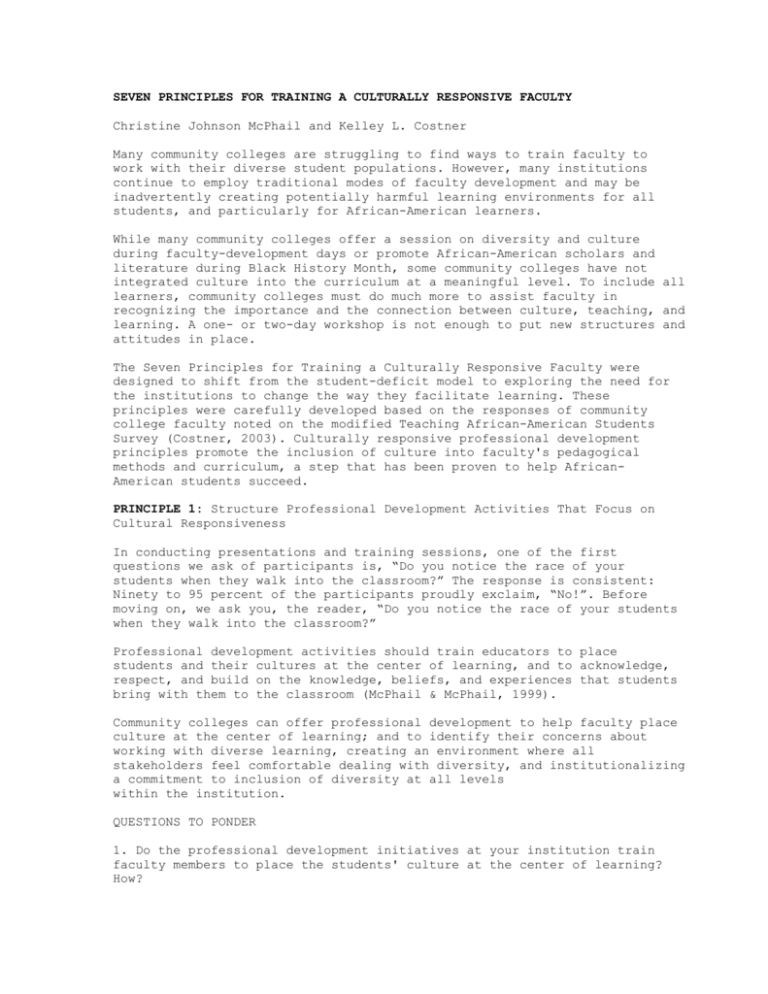seven principles for training a culturally responsive faculty
advertisement

SEVEN PRINCIPLES FOR TRAINING A CULTURALLY RESPONSIVE FACULTY Christine Johnson McPhail and Kelley L. Costner Many community colleges are struggling to find ways to train faculty to work with their diverse student populations. However, many institutions continue to employ traditional modes of faculty development and may be inadvertently creating potentially harmful learning environments for all students, and particularly for African-American learners. While many community colleges offer a session on diversity and culture during faculty-development days or promote African-American scholars and literature during Black History Month, some community colleges have not integrated culture into the curriculum at a meaningful level. To include all learners, community colleges must do much more to assist faculty in recognizing the importance and the connection between culture, teaching, and learning. A one- or two-day workshop is not enough to put new structures and attitudes in place. The Seven Principles for Training a Culturally Responsive Faculty were designed to shift from the student-deficit model to exploring the need for the institutions to change the way they facilitate learning. These principles were carefully developed based on the responses of community college faculty noted on the modified Teaching African-American Students Survey (Costner, 2003). Culturally responsive professional development principles promote the inclusion of culture into faculty's pedagogical methods and curriculum, a step that has been proven to help AfricanAmerican students succeed. PRINCIPLE 1: Structure Professional Development Activities That Focus on Cultural Responsiveness In conducting presentations and training sessions, one of the first questions we ask of participants is, “Do you notice the race of your students when they walk into the classroom?” The response is consistent: Ninety to 95 percent of the participants proudly exclaim, “No!”. Before moving on, we ask you, the reader, “Do you notice the race of your students when they walk into the classroom?” Professional development activities should train educators to place students and their cultures at the center of learning, and to acknowledge, respect, and build on the knowledge, beliefs, and experiences that students bring with them to the classroom (McPhail & McPhail, 1999). Community colleges can offer professional development to help faculty place culture at the center of learning; and to identify their concerns about working with diverse learning, creating an environment where all stakeholders feel comfortable dealing with diversity, and institutionalizing a commitment to inclusion of diversity at all levels within the institution. QUESTIONS TO PONDER 1. Do the professional development initiatives at your institution train faculty members to place the students' culture at the center of learning? How? 2. Do the professional development initiatives at your institution allow for an open and honest discussion about race? How? 3. Are professional development initiatives at your institution an ongoing and continuous effort? 4. Do the professional development initiatives at your institution train faculty members how to effectively teach African-American learners? PRINCIPLE 2: Ensure That All Faculty Respect the Culture of Their Students Once faculty members become comfortable acknowledging the race of their students and accept their cultural differences, faculty members are better equipped to teach African-American learners. Community colleges can use professional development to provide an avenue that allows faculty members to assess their attitudes and beliefs toward teaching African-American learners. Institutions may administer instruments or hire a consultant to facilitate the administration of this type of assessment. Once this assessment is complete, strategies can be developed to train faculty to become more culturally responsive. Colleges can also provide professional development initiatives that educate faculty about the culture of the African American, including, for example, learning styles, cultural heritage, norms, beliefs, and practices. Providing meaningful professional development programs to help faculty deal with their beliefs and attitudes about teaching diverse learners will help to ensure that the learning needs of all learners are addressed. QUESTIONS TO PONDER 1. Do your professional development activities provide faculty with a means to evaluate their own attitudes, beliefs, and perceptions about African Americans? How? 2. Do you acknowledge your students' racial identities? Are you comfortable doing so? 3. Do you think that acknowledging the race of your students makes you racist or prejudice you in some way? Why? PRINCIPLE 3: Value and Celebrate Culture – Promote Cultural Sensitivity Valuing a student's culture in the classroom is another frequently cited factor for successfully teaching African-American learners. Culture determines how one thinks, behaves, and believes, and this in turn affects how faculty teach and learn. Faculty who are cognizant of their own thoughts and behaviors in cross-cultural interaction are better prepared to respond in ways that will improve teaching and learning in culturally diverse classrooms. Cultural sensitivity involves the acceptance that African-American students have a distinct culture and learning style that should be valued, promoted, and embraced in the classroom. Culture is at the heart of what all faculty do in the name of education, whether it is curriculum, instruction, administration, or performance assessment (Gay, 2000). The importance of creating a learning environment where faculty members are comfortable dealing with all barriers to the learning process cannot be overstated. A firm foundation in culturally responsive teaching creates an environment that responds to the influence of the learner's culture on the way the learner learns. QUESTIONS TO PONDER 1. Does your institution promote an environment where faculty members can value the cultural experiences African Americans bring to the classroom with them? If yes, how? If no, do you as an individual faculty member value the cultural experiences African Americans bring to the classroom with them? 2. Does your institution promote cultural sensitivity continuously through programs and services? How? 3. Do you consider or address African-American students' needs when you are designing your course content? How? PRINCIPLE 4: Embrace an Empowerment Culture Our analysis of enrollment trends in the nation's community colleges suggests that faculty in the future will encounter even greater numbers of diverse student populations. Thus, community colleges will need to accelerate their pace in creating faculty development training to address this reality. Community college staff and curriculum developers can look at various cross-cultural faculty training models to assist with professional development of faculty. We believe that professional development programs could be responsive to African-American and other underserved learners by incorporating McPhail and McPhail's Empowerment Culture into their faculty development programs. The Empowerment Culture (McPhail & McPhail, 1999) targeted community colleges that are attempting to transform their classroom practices to meet the needs of African-American students. Community college faculty can cultivate an empowerment culture by * Learning more about the culture of African-American students, * Listening to the voices of learners, * Weaving the realities of learners' lives into the curriculum, * Including positive representations of the African-American cultural heritage in the curriculum, and * Extending and reformulating the theory of cultural mediation into instruction. By focusing on the culture of the learner along with analysis of the scholarly research on cultural responsiveness in the classroom, community colleges will have a viable strategy for improving the learning experiences of the African-American learner. PRINCIPLE 5: Communicate the College's Commitment to Cultural Responsiveness Many institutions and faculty are quick to proclaim they are committed to addressing the needs of their African-American learners. This commitment must extend to helping faculty become committed to infusing culture into the curriculum, thereby benefiting the African-American learner and the college as a whole. Community colleges can train faculty to infuse culture the curriculum by using these strategies: * Committing human and budgetary resources to infusing culture into the curriculum * Displaying the institution's dedication to infusing culture into the curriculum * Offering incentives for faculty to infuse culture into the curriculum * Helping faculty to evaluate their own consciousness and awareness about race in order to remove barriers * Creating pressure for transformation of the instructional delivery system, holding faculty accountable for using the culture of their students in the classroom and placing the culture of students at the center of the learning experience. QUESTIONS TO PONDER 1. How does your institution show commitment to the incorporation of culture into the curriculum? 2. Does your institution offer any type of training to its faculty, staff, and administrators that specifically focuses on cultural training? 3. Do you believe that infusing the students' cultural experiences into the curriculum is important? 4. Do you believe that all students can benefit from the infusion of culture into the curriculum? 5. Is the college's commitment to diversity written in the strategic plan? PRINCIPLE 6: Take Away Barriers that Impede Progress The barriers that many African-American students encounter are not always visible. They can come in the form of hidden curriculum such as purposefully ignoring African-American students' contributions to class discussions; forcing students to learn in an environment that does not support their learning style; showing negative personal attitudes and beliefs; constructing courses that minimize the levels of interaction with students, which limits discussion; and expressing increased differential expectations. Eliminating barriers is an exercise of both mind and method. It takes time and involves institutionwide commitment. We also believe that it is not an option, but an opportunity to add a deeper meaning to the mission of the American community college. QUESTIONS TO PONDER 1. What visible or invisible barriers are in place at your institution and in your classroom that may hinder the academic success of African-American learners? 2. Are there faculty members or administrators at your institution who openly oppose incorporating culture into the curriculum? What is being done to help these faculty members or administrators recognize the benefit of this practice? 3. Do you require students to modify their behaviors to accommodate your classroom environment? If yes, why? PRINCIPLE 7: Help Faculty to Use Effective Pedagogical Methods for Teaching African Americans The pedagogical practices we will describe are not meant to be an exhaustive list of methodologies, but a means to introduce institutions and individuals to some pedagogical practices that have demonstrated success in teaching African-American students. WISE SCHOOLING Steele (1992) described a concept called “wise schooling,” which attempts to dispel the racial vulnerability of African-American students and stresses their potential to learn. Steele labeled four elements as fundamental to the achievement of African-American students: 1. If what is meaningful and important to the teacher is to become meaningful and important to a student, the student must feel valued by the teacher for his or her potential as a student. 2. The challenge and promise of personal fulfillment, not remediation, should guide the education of minority students. Their present skills should be taken into account and they should be moved along at a pace that is demanding but does not defeat them. 3. Racial integration is a generally useful element in education, if not a necessity. Segregation, whatever its purpose, draws out group differences and makes students feel more vulnerable when they inevitably cross group lines to compete in the larger society; 4. The particulars of black life and culture must be present in the mainstream curriculum of American schooling, not confined to special days, weeks, or even months. NAIROBI METHOD The pioneering work of Mary Rhoades Hoover resulted in an approach to literacy instruction for miseducated culturally and linguistically different African Americans (McPhail and McPhail, 1999). The term miseducated means that instruction that has proven effective for AfricanAmerican students has not been provided to them, a problem that is caused by the educational system, not by students. In the Nairobi method, learners are encouraged to undertake collective project work as an integral element of learning. For example, integrate basic literacy with community development activities; integrate basic skills with income-generating projects; and create partnerships with local community groups, with successful role models participating in learning or local businesses working with colleges to identify skill sets. CULTURALLY MEDIATED INSTRUCTION Culturally mediated instruction (CMI) is characterized by the use of culturally mediated cognition, culturally appropriate social situations for learning, and culturally valued knowledge in curriculum content (Hollins, 1996). The premise underlying CMI has two components based on the centrality of the students' home culture in framing memory structures and mental operations (Hollins, 1996). The first component emphasizes that teaching and learning are more meaningful and productive when the curriculum and pedagogical practices include culturally mediated cognition, culturally appropriate social situations for learning, and culturally valued knowledge. Second, the authenticity of schooling is validated for students by the interactions and relationships between adult members of their community and school personnel. This theory, although focused on K-12 populations, can be implemented and is a powerful alternative for community college educators committed to designing classroom and instructional practices that are both multicultural and multicognitive (McPhail & McPhail, 1999). QUESTIONS TO PONDER 1. Does your institution support the use of CMI and other methodologies for teaching African-American students? 2. Do you think that CMI is a viable means for teaching African-American students and other students from diverse cultures? 3. Do you think that if an African-American student has a curriculum that is culturally affirming, that student will be successful? Why? We envision a nation of community colleges that fulfill their promise to all learners. Community colleges generally enjoy a positive image with the students they serve. In too many cases, this image is tarnished by their track record in promoting the academic success of African-American students. For example, African Americans and other students of color continue to experience educational disparities when compared to other learners. We believe that faculty-student interaction is at the core of the educational disparities experienced by African-American learners. Community colleges should consider positioning cultural responsiveness at the core of their central mission statement, not as something to get around to when it is convenient or politically correct. We advocate the elimination of educational disparities between African-American learners and other underserved learners in the community college, and we believe that culturally responsive teaching is at the core of the conversation. REFERENCES Costner, K. L. (2003). The Struggle Continues: Community College Faculty Attitudes Toward Teaching African-American Students. Dissertation Abstracts International, 64 (05), p. 1506 (UMI 3090068). Gay, G. (2000). Culturally Responsive Teaching : Theory, Research, and Practice. New York : Faculty College Press. Hollins, E.R. (1996). Culture in School Learning : Revealing the Deep Meaning. Mahwah, NJ : Erlbaum. McPhail, I.P., & McPhail, C.J. (1999). Transforming Classroom Practice for African-American Learners: Implication for the Learning Paradigm. Removing Vestiges, 25-35. Steele, C.M. (1992, April). R ace and the Schooling of Black Americans. The Atlantic Monthly, 269 (4), pp. 67-78. _______________________________________________________________ Kelley L. Costner mailto: kelleycostner@comcast.net is Assistant Professor of Reading at The Community College of Baltimore County. Christine Johnson McPhail mailto:cmcphail@jewel.morgan.edu is Graduate Coordinator of the Community College Leadership Program at Morgan State University. _______________________________________________________________ ** To view the web version of this abstract, in printer friendly layout, go to http://www.league.org/publication/abstracts/learning/lelabs0412.html **







